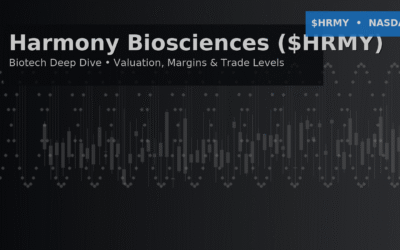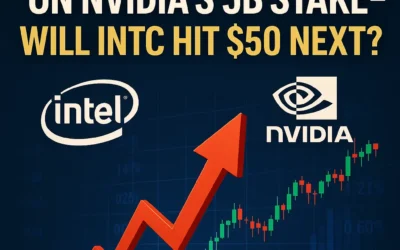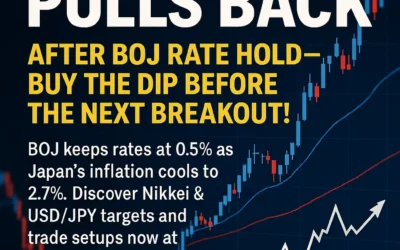Introduction to Swing Trading
Welcome to our guide on swing trading, an investment strategy designed to capitalize on short- to medium-term price movements. This article outlines a robust decision-making framework to enhance your swing trading effectiveness, leveraging critical criteria for stock selection and analysis.
For those who prefer selecting individual stocks, it is crucial to first understand what type of investor you are. To help with this, we have created three articles summarizing the three main types of investors: Value Investors, Growth Investors, and GARP Investors. Additionally, for those interested in passive investment strategies over a very long term (20-30 years), our guide on building a robust ETF portfolio offers comprehensive insights. Furthermore, you can explore our article on how to invest in commodities.
What is Swing Trading?
Swing trading is a style of trading that seeks to capture gains in a stock (or any financial instrument) within an overnight hold to several weeks. It sits between day trading, where positions are closed within a single trading day, and trend trading, where positions are held for several months. Swing traders primarily use technical analysis due to the short-term nature of the trades, but they may also use fundamental analysis or a combination of both to make their trading decisions.
Benefits of Swing Trading
Swing trading can be a suitable strategy for those who cannot dedicate all their time to trading. Unlike day trading or scalping, which require constant monitoring of the markets throughout the trading day, swing trading allows for more flexibility.
Comparing Swing Trading, Day Trading, and Scalping
Several studies and surveys indicate that the majority of day traders and scalpers do not achieve consistent profitability. For instance, research by the U.S. Securities and Exchange Commission (SEC) shows that approximately 70-80% of day traders lose money over the long term. A study by the University of California, Davis, found that only 1% of day traders were profitable net of fees.
Conversely, swing trading and long-term investing tend to yield better results. Portfolio managers in hedge funds, mutual funds, venture capital, and private equity often rely on swing trading and long-term strategies to achieve substantial gains. According to a report by the National Bureau of Economic Research (NBER), hedge funds that employ swing trading strategies often outperform those that engage in high-frequency trading (HFT) and day trading.
Here’s a comparison table to highlight the differences between swing trading, day trading, and scalping:
| Aspect | Swing Trading | Day Trading | Scalping |
|---|---|---|---|
| Time Commitment | Moderate (hours to weeks) | High (all-day monitoring) | Very High (constant monitoring) |
| Trade Duration | Days to weeks | Minutes to hours | Seconds to minutes |
| Frequency of Trades | Low to moderate | High | Very High |
| Stress Level | Moderate | High | Very High |
| Potential Returns | Moderate to high | High | Low to moderate |
| Risk Level | Moderate | High | Very High |
| Required Knowledge | Moderate to high | High | High |
| Technical Analysis | Essential | Essential | Essential |
| Fundamental Analysis | Useful but not essential | Less emphasis | Minimal |
| Capital Requirement | Moderate | High | Variable |
A Comprehensive Swing Trading Framework
The decision-making process we propose is both efficient and effective, utilizing a series of rigorously selected criteria relevant to swing trading. This framework can be directly implemented using tool like GuruFocus, which provide updated data and relevant indicators. Through comprehensive backtesting on our portfolio, this process has proven effective for both short-term and medium-term trades, demonstrating its reliability in identifying potential trading opportunities.
This decision-making framework is derived from the book Biotech Boom by Fatih AK. For a deeper understanding and more detailed strategies, I highly recommend reading it. Please note that this is an affiliate link, and I will earn a commission if you purchase the book through.
| Category | Criterion/Step | Description/Target | Yes (1) | No (0) | References |
|---|---|---|---|---|---|
| Basic Criteria | Closing and Opening Prices | Are the daily closing and opening prices analyzed graphically? | GuruFocus, Yahoo Finance | ||
| Stock Price | Is the stock priced under $5? | GuruFocus, Finviz, Yahoo Finance | |||
| Market Capitalization | Is the market capitalization under $2 billion? | GuruFocus, Finviz, Morningstar | |||
| Sector | Is the stock in a sector like technology, healthcare, finance, etc.? | GuruFocus, Finviz, Morningstar | |||
| Technical Criteria | 52-Week Low | Is the stock within 50% of its 52-week low? | GuruFocus, Finviz, Yahoo Finance | ||
| Golden Cross | Has the 50-day SMA crossed above the 200-day SMA, or the 20-day SMA above the 50-day SMA? | GuruFocus, Finviz, Yahoo Finance | |||
| RSI (Relative Strength Index) | Is the RSI between 40 and 60? | GuruFocus, Finviz, Yahoo Finance | |||
| Volume and Average Daily Volume | Is the daily volume between 1 and 2 million? | GuruFocus, Finviz, Yahoo Finance | |||
| Valuation Parameters | P/E Ratio | Is the P/E ratio less than 80% of the market average CAPE ratio or below 15? | GuruFocus, Finviz, Morningstar | ||
| P/S Ratio | Is the P/S ratio less than 2? | GuruFocus, Finviz, Morningstar | |||
| PEG Ratio | Is the PEG ratio less than 2? | GuruFocus, Finviz, Morningstar | |||
| PCF Ratio | Is the PCF ratio less than 15? | GuruFocus, Finviz, Morningstar | |||
| Financial Criteria | Earnings Date | Are the upcoming earnings reports monitored? | GuruFocus, Finviz, Yahoo Finance | ||
| EPS Growth | Has the EPS shown positive growth compared to previous quarters? | GuruFocus, Finviz, Yahoo Finance | |||
| Cash Flow | Does the company have at least 12 months of cash flow? | GuruFocus, Finviz, Yahoo Finance | |||
| Debt-to-Equity Ratio | Is the debt-to-equity ratio less than 1.0? | GuruFocus, Finviz, Morningstar | |||
| Cash Availability | Does the company have 12-24 months of available cash? | GuruFocus, Finviz, Yahoo Finance | |||
| Ownership Structure | Insider Ownership | Is the insider ownership greater than 20%? | GuruFocus, Finviz, Yahoo Finance | ||
| Institutional Ownership | Is the institutional ownership less than 20%? | GuruFocus, Finviz, Yahoo Finance | |||
| Float | Is the float less than 100 million? | GuruFocus, Finviz, Yahoo Finance | |||
| Short Float | Is the short float less than 5%? | GuruFocus, Finviz, Yahoo Finance | |||
| Catalysts | Diversified Pipeline | Does the company have a diversified range of products or services in development? | GuruFocus, Finviz, Company Reports | ||
| Regulatory Status | Do the products have significant regulatory designations or approvals? | GuruFocus, Finviz, Company Reports | |||
| Catalyst Dates | Are there confirmed catalyst dates within the next three months? | GuruFocus, Finviz, Company Reports |
To decide whether to buy a stock for swing trading, aim for an optimal score of 12 to 17 points out of the total 24 criteria. This range indicates a balanced evaluation of the stock’s potential based on the comprehensive criteria outlined above
For those who want to move faster and benefit from our trading positions and consult our constantly updated, catalyst-focused portfolios offering parabolic movements, you can access them via the following link: Investment Portfolios.
Conclusion
Integrating these scores into your strategy helps avoid companies with significant financial risks. However, the primary goal in swing trading is to capitalize on short-term price movements without holding positions long-term. The total of 24 criteria aims to achieve an optimal score of 12 to 17 points to consider a stock a potential trading opportunity.
For a more detailed and precise framework (quantitative, qualitative, technical, fundamental), readers can explore our other articles and the following book, which is probably one of the most concise on the topic: The Art of Unearthing Gems in the Stock Market. This resource is perfect for investors of all levels and offers in-depth insights into proven strategies for achieving true success in the stock market. Please note that this is an affiliate link, and I will earn a commission if you purchase the book through it.
For those interested in starting their investment journey, consider using our affiliate link for Trade Republic. By using this link, you will receive a €10 bonus in shares as a gift: Trade Republic.
Stay tuned for more expert advice and join our community of informed investors by subscribing to our newsletter. To join us, simply click the “Join our newsletter” button at the top right for free analyses, ideas, and lessons. To receive alerts for taking positions, lightening, and rebalancing, subscribe to our newsletter or pay for premium access via the link: Subscribe.









0 Comments